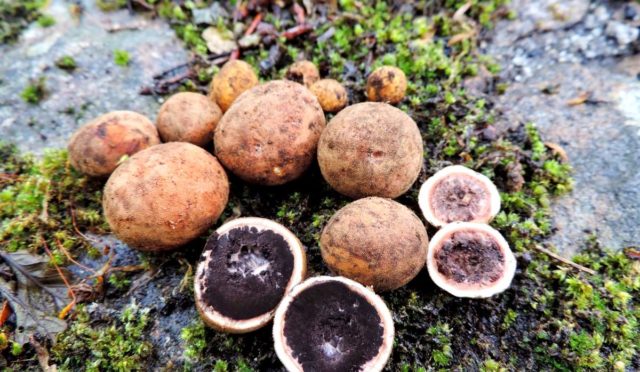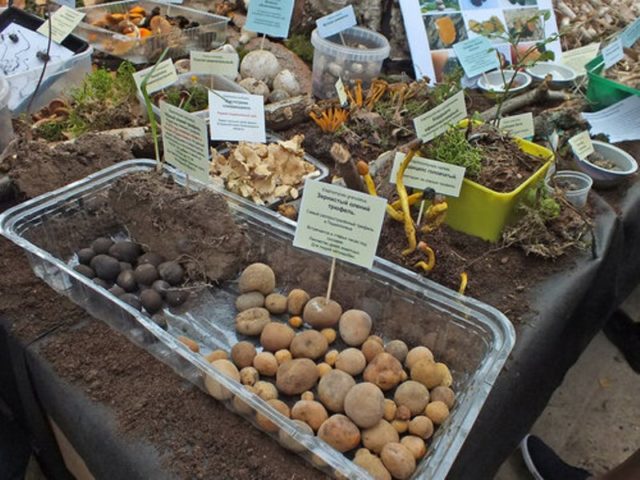Content
Reindeer truffle (Elaphomyces granulatus) is an inedible mushroom of the Elaphomycetes family. The species has other names:
- deer raincoat;
- granular truffle;
- granular elafomyces;
- parga;
- lady;
- purgashka.
Reindeer truffle is eagerly eaten by squirrels, hares and deer, which is why its Latin name originated. "Elapho" in translation means "deer", "myces" - "mushroom".

Reindeer truffle looks like a potato tuber
What does a deer truffle look like?
The fruit bodies of the deer truffle develop shallowly underground - in the humus layer at the level of 2-8 cm. They are characterized by an irregular spherical shape, the surface of the fungus may be wrinkled. The size of the fruit bodies reaches 1-4 cm in diameter. Reindeer truffle is covered with a dense two-layer white shell (peridium) with a thickness of 1-2 mm. When cut, the flesh of the crust changes color to pinkish gray. Outside, the mushroom is covered with small warts, which explains its specific epithet "granulatus". The superficial tubercles are pyramidal in shape with a height of about 0.4 mm. The outer layer of a granular truffle can be:
- yellowish brown;
- ocher brown;
- yellowish ocher;
- golden brown;
- rusty brown;
- dark brown.
In young specimens, the flesh is light marble, divided into compartments by partitions. As it matures, the inside of the fungus turns into a deep purple or purplish brown dust. Microscopic spores are spherical with spines, ranging in color from reddish brown to almost black.
The pulp tastes bitter. The smell is earthy, well expressed, somewhat reminiscent of raw potatoes.
Reindeer truffle mycelium permeates the soil around the fruit bodies. Its yellow threads are densely woven into the soil and twine around the roots of trees. It is possible to detect the parga mushroom by the presence in the forest of another species that parasitizes on it - Cordyceps ophioglossoides (Tolypocladium ophioglossoides). Its black fruit bodies in the form of a club indicate that deer truffles can be found at a depth of 15 cm.

Ophiroglossoid gordyceps is a mushroom that feeds on the remains of the fruiting bodies of underground fungi of the genus Tolipocladium
Where does the reindeer truffle mushroom grow?
Parga is the most common mushroom in the Elafomitses genus. Reindeer truffle is found throughout the Northern Hemisphere, from the tropics to the subarctic regions. The area covers Europe and North America, China, Taiwan, the islands of Japan.
Reindeer truffle prefers to settle in the coastal zone, although it is sometimes found in mountainous areas at an altitude of 2700-2800 m above sea level. The fungus loves acidic sandy or podzolic soil. It grows more often in virgin protected forests, less often in young plantings.
Forms mycorrhiza with conifers, as well as with some deciduous species, such as:
- oak;
- beech;
- chestnut.
Reindeer truffle can be found at any time of the year, depending on the region of growth. The most widespread fruiting of parga is observed in late summer and early autumn.
The destruction of old forests has a detrimental effect on the reindeer truffle populations.And although it is considered quite common, it is becoming rare in some European countries. For example, in Bulgaria, the representative is listed in the Red Book as a species that is critically endangered.
Can you eat a deer truffle?
Reindeer truffle is not recommended for food. However, forest dwellers feed on its fruit bodies, which are dug out of the ground. A squirrel can smell fallow under a layer of snow 70-80 cm thick. These rodents not only eat fresh mushrooms, nibbling the shell, but also store them for the winter. Hunters use the parga as bait.
The nutritional value of this species is low. The cascading ground squirrel can assimilate only 30% of its proteins. Fruit bodies are capable of accumulating large amounts of cesium, and the shell contains 8.6 times more of it than spores. Colossal amounts of the radioactive nuclide cesium-137 were released into the environment as a result of the man-made disaster at the Chernobyl nuclear power plant in 1986. The echoes of the accident still negatively affect the environmental situation in some European countries.

Elafomitses granular at the Moscow mushroom exhibition
Although parga cannot be eaten, it has found application in traditional medicine. Siberian sorcerers called the representative nothing more than "the elixir of the mushroom queen." Drugs based on it were considered a strong aphrodisiac, used to recuperate after a serious illness or injury. A mixture of pine nuts, honey and crushed parga cured consumption and other diseases. In Poland, childless couples were given a mushroom tincture on red wine. Unfortunately, the exact prescriptions for these medicines have been lost.
Conclusion
Having found a deer truffle in the forest that looks like a walnut with numerous pimples on the surface, you do not need to dig it out for fun or idle interest. The mushroom serves as food for many species of forest animals and will please, if not bears, then hares, squirrels and ungulates for sure.








